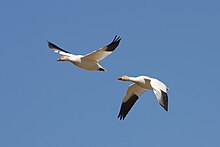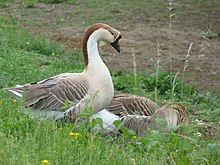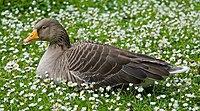Guske — разлика између измена
мНема описа измене |
. |
||
| Ред 1: | Ред 1: | ||
{{Rut}} |
|||
{{друго значење|истоимено насеље|[[Гуска (Ђаковица)|Гуска]]}} |
|||
[[File:Anser anser 1 (Piotr Kuczynski).jpg|thumb|right|250px|Divlja guska (''[[Anser anser]]'').]] |
|||
{{Taxobox |
|||
| name = Гуска |
|||
| image = Geese Fruggo02.JPG |
|||
| image_width = 250п |
|||
| image_caption = Гуске |
|||
| regnum = -{[[Животиње|Animalia]]}- |
|||
| phylum = -{[[Хордати|Chordata]]}- |
|||
| classis = -{[[Птице|Aves]]}- |
|||
| ordo = -{[[Пловуше|Anseriformes]]}- |
|||
| familia = -{[[Anatidae]]}- |
|||
| subfamilia = -{[[Гуске|Anserinae]]}- |
|||
| genus = '''''-{Anser}-''''' |
|||
| genus_authority = -{[[Жак Брисон|Brisson]]}-, 1760. |
|||
| subdivision_ranks = Врсте |
|||
| subdivision = |
|||
види текст |
|||
| synonyms = |
|||
''-{Cygnopsis}-''<br/> |
|||
''-{Cycnopsis}-''<br/> |
|||
''-{Eulabeia}-''<br/> |
|||
''-{Heterochen}-'' |
|||
}} |
|||
'''Пољске гуске''' или '''гуска''' ({{јез-лат|Anser}}) је [[Род (биологија)|род]] [[Птице|птица]] средње величине из породице [[пловке]] (Anatidae). Највећи део ових [[Животиње|животиња]] има склоност ка сезонској миграцији. Гуска се дуги низ година узгаја и као [[Домаћа гуска|домаћа]] животиња. |
|||
'''Guska''' (množina '''guske''') ptica je jedne od nekoliko vrsta [[Пловуше|plovuša]] u [[family (biology)|familiji]] -{''[[Anatidae]]''}-. This group comprises the genera ''[[Anser (bird)|Anser]]'' (the grey geese), ''[[Branta]]'' (the black geese), and ''[[Chen (genus)|Chen]]'' (which includes the white geese); the latter being commonly placed within the genus ''Anser''. Some other [[bird]]s, mostly related to the [[shelduck]]s, have "goose" as part of their names. More distantly related members of the family Anatidae are [[swan]]s, most of which are larger than true geese, and [[duck]]s, which are smaller. |
|||
== Списак савремених врста == |
|||
* [[Дивља гуска]] (''-{Anser anser}-'') |
|||
** [[Домаћа гуска]] (''-{Anser anser domesticus}-'') |
|||
* [[Лисаста гуска]] ''-{Anser albifrons}-'' |
|||
** [[Гренландска лисаста гуска]] (''-{Anser albifrons flavirostris}-'') |
|||
* [[Мала лисаста гуска]] (''-{Anser erythropus}-'') |
|||
* [[Гуска глоговњача]] или велика љигарица (''-{Anser fabalis}-'') |
|||
** [[Мала љигарица]] (''-{Anser (fabalis) serrirostris}-'')<ref>Напомена: Према Америчком орнитолошком савезу мала љигарица је посебна врста, а не подврста гуске глоговњаче (велике љигарице).</ref> |
|||
* [[Краткокљуна гуска]] (''-{Anser brachyrhynchus}-'') |
|||
* [[Индијска гуска]] (''-{Anser indicus}-'') |
|||
* [[Кинеска лабудаста гуска]] (''-{Anser cygnoides}-'') |
|||
** [[Домаћа гуска]] (''-{Anser cygnoides domesticus}-'') |
|||
The term "goose" is more properly used for a female bird, while "'''gander'''" refers specifically to a male one. Young birds before fledging are called '''goslings'''.<ref name=Partridge/> The [[List of collective nouns|collective noun]] for a group of geese on the ground is a '''gaggle'''; when in flight, they are called a '''skein''', a '''team''', or a '''wedge'''; when flying close together, they are called a '''plump'''.<ref>{{cite web |archive-url=https://web.archive.org/web/20081020120740/http://www.askoxford.com/asktheexperts/collective/g/ |url=http://www.askoxford.com/asktheexperts/collective/g/ |title=AskOxford: G |access-date=19 September 2011 |work=Collective Terms for Groups of Animals |publisher=Oxford University Press |location=Oxford, United Kingdom |archive-date=20 October 2008}}</ref> |
|||
== Угроженост == |
|||
Због прекомерног лова и уништења станишта неке врсте су мање или више угрожене. Мала лисаста гуска (''Anser erythropus'') и кинеска лабудаста гуска (''Anser cygnoides'') су на црвеној листи означене као рањиве врсте.<ref>IUCN Red List of Threatened Species [http://www.iucnredlist.org/details/22679869/0 Anser cygnoides]</ref> |
|||
== |
== Etimologija == |
||
The word "goose" is a direct descendant of [[Proto-Indo-European language|Proto-Indo-European]] root, ''ghans-''. In [[Germanic language]]s, the root gave [[Old English]] ''gōs'' with the plural ''gēs'' and ''gandres'' (becoming Modern English goose, geese, gander, and gosling, respectively), [[West Frisian language|Frisian]] ''goes'', ''gies'' and ''guoske'', [[New High German]] ''Gans'', ''Gänse'', and ''Ganter'', and [[Old Norse]] ''gās''. This term also gave {{lang-lt|žąsìs}}, {{lang-ga|gé}} (goose, from [[Old Irish]] ''géiss''), {{lang-la|anser}}, [[Ancient Greek language|Ancient]] {{lang-el|χήν}} (''khēn''), {{lang-nl|gans}}, {{lang-sq|gatë}} (heron), [[Sanskrit]] ''hamsa'' and ''hamsi'', {{lang-fi|hanhi}}, [[Avestan]] ''zāō'', {{lang-pl|gęś}}, {{lang-ro|gâscă / gânsac}}, {{lang-uk|гуска / гусак}} (''guska'' / ''gusak''), {{lang-ru|гусыня / гусь}} (''gusyna'' / ''gus''), {{lang-cs|husa}}, and {{lang-fa|{{Nastaliq|غاز}}}} (''ghāz'').<ref name=Partridge>{{Cite book |last=Partridge |first=Eric |authorlink=Eric Partridge |title=Origins: a Short Etymological Dictionary of Modern English |publisher=Greenwich House |year=1983 |location=New York |isbn=0-517-414252 |pages=245–246}}</ref><ref>{{cite book |last=Crystal |first=David |year=1998 |title=The Cambridge Encyclopedia of Language |isbn=0-521-55967-7}}</ref> |
|||
{{reflist|2}} |
|||
== Prave guske i njihovi srodnici == |
|||
== Спољашње везе == |
|||
[[File:Anser caerulescens CT8.jpg|thumb|left|[[Snow geese]] in [[Quebec]], [[Canada]]]] |
|||
* [https://agroplus.rs/serijal-lovstvo-u-vojvodini-59/ О распрострањењу и детерминацији гусака љигарица] |
|||
[[File:Bütykös lúd - Gergelyiugornya.JPG|thumb|[[Chinese geese]], the domesticated form of the [[swan goose]]]] |
|||
{{Commonscat|Anser}} |
|||
The three living [[genus|genera]] of true geese are: ''[[Anser (genus)|Anser]]'', grey geese, including the [[greylag goose]], and [[Domestic goose|domestic geese]]; ''[[Chen (genus)|Chen]]'', white geese (often included in ''Anser''); and ''[[Branta]]'', black geese, such as the [[Canada goose]]. |
|||
{{клица-птице}} |
|||
{{Taxonbar}} |
|||
Two genera of geese are only tentatively placed in the Anserinae; they may belong to the [[shelduck]]s or form a subfamily on their own: ''[[Cereopsis]]'', the Cape Barren goose, and ''[[Cnemiornis]]'', the prehistoric New Zealand goose. Either these or, more probably, the goose-like [[Coscoroba swan]] is the closest living relative of the true geese. |
|||
[[Категорија:Гуске|*]] |
|||
[[Fossil]]s of true geese are hard to assign to genus; all that can be said is that their fossil record, particularly in [[North America]], is dense and comprehensively documents many different species of true geese that have been around since about 10 [[million years ago]] in the [[Miocene]]. The aptly named ''Anser atavus'' (meaning "progenitor goose") from some 12 million years ago had even more [[plesiomorph]]ies in common with swans. In addition, some goose-like birds are known from [[subfossil]] remains found on the [[Hawaiian Islands]]. |
|||
Geese are [[Monogamous pairing in animals|monogamous]], living in permanent pairs throughout the year; however, unlike most other permanently monogamous animals, they are territorial only during the short nesting season. Paired geese are more dominant and feed more, two factors that result in more young.<ref>{{cite journal |last=Lamprecht |first=Jürg |title=Female reproductive strategies in bar-headed geese (''Anser indicus''): Why are geese monogamous? |journal=Behavioral Ecology and Sociobiology |volume=21 |issue=5 |pages=297–305 |publisher=Springer |year=1987 |doi=10.1007/BF00299967}}</ref> |
|||
== Druge ptica zvane „guske” == |
|||
{{multiple image |align=right |direction=vertical |
|||
|image1=Greylag Goose in St James's Park, London - May 2006.jpg |caption1=[[Greylag goose]] at [[St. James's Park]], [[London]], the [[United Kingdom]] |width1= |
|||
|image2=Cereopsis novaehollandiae 2.jpg |caption2=[[Cape Barren goose]] in [[Maria Island]], [[Australia]] |width2=}} |
|||
Some mainly [[Southern Hemisphere]] birds are called "geese", most of which belong to the [[shelduck]] subfamily [[Tadorninae]]. These are: |
|||
* [[Orinoco goose]], ''Neochen jubata'' |
|||
* [[Egyptian goose]], ''Alopochen aegyptiaca'' |
|||
* The South American [[sheldgoose|sheldgeese]], genus ''Chloephaga'' |
|||
* The [[Late Quaternary prehistoric birds|prehistoric]] [[Malagasy sheldgoose]], ''Centrornis majori'' |
|||
Others: |
|||
* The [[spur-winged goose]], ''Plectropterus gambensis'', is most closely related to the shelducks, but distinct enough to warrant its own subfamily, the [[Plectropterinae]]. |
|||
* The [[blue-winged goose]], ''Cyanochen cyanopterus'', and the [[Cape Barren goose]], ''Cereopsis novaehollandiae'', have disputed affinities. They belong to separate ancient lineages that may ally either to the [[Tadorninae]], [[Anserinae]], or closer to the dabbling ducks (Anatinae). |
|||
* The three species of small waterfowl in the genus ''[[Nettapus]]'' are named "pygmy geese". They seem to represent another ancient lineage, with possible affinities to the Cape Barren goose or the spur-winged goose. |
|||
* A genus of prehistorically [[extinct]] [[seaduck]]s, ''[[Chendytes]]'', is sometimes called "diving-geese" due to their large size.<ref>{{Cite journal|title=New Records and a New Species of Chendytes, an Extinct Genus of Diving Geese |first=Hildegarde |last=Howard |journal=The Condor |volume=57 |issue=3 |year=1955 |pages=135–143 |doi=10.2307/1364861 |jstor=1364861}}</ref> |
|||
* The unusual [[magpie goose]] is in a family of its own, the Anseranatidae. |
|||
* The [[northern gannet]], a seabird, is also known as the "Solan goose", although it is a bird unrelated to the true geese, or any other [[Anseriformes]] for that matter. |
|||
== U popularnoj kulturi == |
|||
Well-known sayings about geese include: |
|||
* To "have a gander" is to examine something in detail. |
|||
* {{anchor|sauce}} "What's sauce for the goose is sauce for the gander" or "What's good for the goose is good for the gander" means that what is an appropriate treatment for one person is equally appropriate for someone else. |
|||
* Saying that someone's "goose is cooked" means that they have suffered, or are about to suffer, a terrible setback or misfortune. |
|||
* The common phrase "silly goose" which is used when referring to someone who is acting particularly silly. |
|||
* "[[The Goose That Laid the Golden Eggs|Killing the goose that lays the golden eggs]]," derived from an old fable, is a saying referring to any greed-motivated, unprofitable action that destroys or otherwise renders a favourable situation useless. |
|||
* "A wild goose chase" is a useless, futile waste of time and effort. |
|||
* There is a legendary old woman called [[Mother Goose]] who wrote nursery rhymes for children. |
|||
==="Gray Goose Laws" in Iceland=== |
|||
The oldest collection of [[Icelandic Commonwealth| Medieval Icelandic]] laws is known as ''"Grágás"'', i.e. the ''[[Gray Goose Laws]]''. |
|||
Various etymologies were offered for that name: |
|||
* The fact that the laws were written with a goose quill; |
|||
* The fact that the laws were bound in goose skin; |
|||
* Because of the age of the laws — it was then believed that geese lived longer than other birds.<ref>Boulhosa, Patricia Press. “The Law of Óláfr inn Helgi.” In ''Icelanders and the Kings of Norway: Mediaeval Sagas and Legal Texts''. Leiden, Netherlands: Brill, 2005.</ref><ref>Byock, Jesse L., ''[https://books.google.com/books?id=A4S6Bnw3HnkC&printsec=frontcover&source=gbs_navlinks_s#v=onepage&q=&f=false Medieval Iceland: Society, Sagas, and Power]'', Berkeley: University of California, 1990</ref><ref>Byock, Jesse L. "Grágás: ''The 'Grey Goose' Law'' in ''Viking Age Iceland'' London: Penguin, 2001.</ref> |
|||
== Galerija == |
|||
<gallery widths="250px" heights="180px" mode=packed-hover > |
|||
File:Canada goose gosling - natures pics.jpg|Bire kanadske guske |
|||
File:Branta canadensis in flight, Great Meadows National Wildlife Refuge.jpg|Kanadske guske u letu |
|||
</gallery> |
|||
== Reference == |
|||
{{Reflist}} |
|||
== Literatura == |
|||
{{Refbegin}} |
|||
*{{cite book|last=Carboneras|first= Carles |year=1992|chapter= Family Anatidae (Ducks, Geese and Swans) |editor1-last=del Hoyo |editor1-first=Josep |editor2-last=Elliott |editor2-first=Andrew |editor3-last=Sargatal |editor3-first=Jordi|title=[[Handbook of Birds of the World]]. Volume 1: Ostrich to Ducks|pages= 536–629|publisher=Lynx Edicions|location= Barcelona|isbn=84-87334-10-5}} |
|||
*{{cite book|last=Terres|first= John K. |author2= [[National Audubon Society]] |year=1991|title=The Audubon Society Encyclopedia of North American Birds|publisher= Wings Books|location= New York|origyear= 1980 |isbn=0-517-03288-0}} |
|||
{{Refend}} |
|||
== Spoljašnje veze == |
|||
{{Commons category-lat|Geese}} |
|||
* -{[http://ibc.lynxeds.com/family/ducks-geese-swans-anatidae Anatidae media] on the Internet Bird Collection}- |
|||
{{Taxonbar-lat|from=Q82562}} |
|||
{{Authority control-lat}} |
|||
[[Категорија:Гуске]] |
|||
Верзија на датум 25. август 2019. у 22:12
Један корисник управо ради на овом чланку. Молимо остале кориснике да му допусте да заврши са радом. Ако имате коментаре и питања у вези са чланком, користите страницу за разговор.
Хвала на стрпљењу. Када радови буду завршени, овај шаблон ће бити уклоњен. Напомене
|

Guska (množina guske) ptica je jedne od nekoliko vrsta plovuša u familiji Anatidae. This group comprises the genera Anser (the grey geese), Branta (the black geese), and Chen (which includes the white geese); the latter being commonly placed within the genus Anser. Some other birds, mostly related to the shelducks, have "goose" as part of their names. More distantly related members of the family Anatidae are swans, most of which are larger than true geese, and ducks, which are smaller.
The term "goose" is more properly used for a female bird, while "gander" refers specifically to a male one. Young birds before fledging are called goslings.[1] The collective noun for a group of geese on the ground is a gaggle; when in flight, they are called a skein, a team, or a wedge; when flying close together, they are called a plump.[2]
Etimologija
The word "goose" is a direct descendant of Proto-Indo-European root, ghans-. In Germanic languages, the root gave Old English gōs with the plural gēs and gandres (becoming Modern English goose, geese, gander, and gosling, respectively), Frisian goes, gies and guoske, New High German Gans, Gänse, and Ganter, and Old Norse gās. This term also gave литв. žąsìs, ир. gé (goose, from Old Irish géiss), лат. anser, Ancient грч. χήν (khēn), хол. gans, алб. gatë (heron), Sanskrit hamsa and hamsi, фин. hanhi, Avestan zāō, пољ. gęś, рум. gâscă / gânsac, укр. гуска / гусак (guska / gusak), рус. гусыня / гусь (gusyna / gus), чеш. husa, and перс. غاز (ghāz).[1][3]
Prave guske i njihovi srodnici


The three living genera of true geese are: Anser, grey geese, including the greylag goose, and domestic geese; Chen, white geese (often included in Anser); and Branta, black geese, such as the Canada goose.
Two genera of geese are only tentatively placed in the Anserinae; they may belong to the shelducks or form a subfamily on their own: Cereopsis, the Cape Barren goose, and Cnemiornis, the prehistoric New Zealand goose. Either these or, more probably, the goose-like Coscoroba swan is the closest living relative of the true geese.
Fossils of true geese are hard to assign to genus; all that can be said is that their fossil record, particularly in North America, is dense and comprehensively documents many different species of true geese that have been around since about 10 million years ago in the Miocene. The aptly named Anser atavus (meaning "progenitor goose") from some 12 million years ago had even more plesiomorphies in common with swans. In addition, some goose-like birds are known from subfossil remains found on the Hawaiian Islands.
Geese are monogamous, living in permanent pairs throughout the year; however, unlike most other permanently monogamous animals, they are territorial only during the short nesting season. Paired geese are more dominant and feed more, two factors that result in more young.[4]
Druge ptica zvane „guske”
Some mainly Southern Hemisphere birds are called "geese", most of which belong to the shelduck subfamily Tadorninae. These are:
- Orinoco goose, Neochen jubata
- Egyptian goose, Alopochen aegyptiaca
- The South American sheldgeese, genus Chloephaga
- The prehistoric Malagasy sheldgoose, Centrornis majori
Others:
- The spur-winged goose, Plectropterus gambensis, is most closely related to the shelducks, but distinct enough to warrant its own subfamily, the Plectropterinae.
- The blue-winged goose, Cyanochen cyanopterus, and the Cape Barren goose, Cereopsis novaehollandiae, have disputed affinities. They belong to separate ancient lineages that may ally either to the Tadorninae, Anserinae, or closer to the dabbling ducks (Anatinae).
- The three species of small waterfowl in the genus Nettapus are named "pygmy geese". They seem to represent another ancient lineage, with possible affinities to the Cape Barren goose or the spur-winged goose.
- A genus of prehistorically extinct seaducks, Chendytes, is sometimes called "diving-geese" due to their large size.[5]
- The unusual magpie goose is in a family of its own, the Anseranatidae.
- The northern gannet, a seabird, is also known as the "Solan goose", although it is a bird unrelated to the true geese, or any other Anseriformes for that matter.
U popularnoj kulturi
Well-known sayings about geese include:
- To "have a gander" is to examine something in detail.
- "What's sauce for the goose is sauce for the gander" or "What's good for the goose is good for the gander" means that what is an appropriate treatment for one person is equally appropriate for someone else.
- Saying that someone's "goose is cooked" means that they have suffered, or are about to suffer, a terrible setback or misfortune.
- The common phrase "silly goose" which is used when referring to someone who is acting particularly silly.
- "Killing the goose that lays the golden eggs," derived from an old fable, is a saying referring to any greed-motivated, unprofitable action that destroys or otherwise renders a favourable situation useless.
- "A wild goose chase" is a useless, futile waste of time and effort.
- There is a legendary old woman called Mother Goose who wrote nursery rhymes for children.
"Gray Goose Laws" in Iceland
The oldest collection of Medieval Icelandic laws is known as "Grágás", i.e. the Gray Goose Laws.
Various etymologies were offered for that name:
- The fact that the laws were written with a goose quill;
- The fact that the laws were bound in goose skin;
- Because of the age of the laws — it was then believed that geese lived longer than other birds.[6][7][8]
Galerija
-
Bire kanadske guske
-
Kanadske guske u letu
Reference
- ^ а б Partridge, Eric (1983). Origins: a Short Etymological Dictionary of Modern English. New York: Greenwich House. стр. 245—246. ISBN 0-517-414252.
- ^ „AskOxford: G”. Collective Terms for Groups of Animals. Oxford, United Kingdom: Oxford University Press. Архивирано из оригинала 20. 10. 2008. г. Приступљено 19. 9. 2011.
- ^ Crystal, David (1998). The Cambridge Encyclopedia of Language. ISBN 0-521-55967-7.
- ^ Lamprecht, Jürg (1987). „Female reproductive strategies in bar-headed geese (Anser indicus): Why are geese monogamous?”. Behavioral Ecology and Sociobiology. Springer. 21 (5): 297—305. doi:10.1007/BF00299967.
- ^ Howard, Hildegarde (1955). „New Records and a New Species of Chendytes, an Extinct Genus of Diving Geese”. The Condor. 57 (3): 135—143. JSTOR 1364861. doi:10.2307/1364861.
- ^ Boulhosa, Patricia Press. “The Law of Óláfr inn Helgi.” In Icelanders and the Kings of Norway: Mediaeval Sagas and Legal Texts. Leiden, Netherlands: Brill, 2005.
- ^ Byock, Jesse L., Medieval Iceland: Society, Sagas, and Power, Berkeley: University of California, 1990
- ^ Byock, Jesse L. "Grágás: The 'Grey Goose' Law in Viking Age Iceland London: Penguin, 2001.
Literatura
- Carboneras, Carles (1992). „Family Anatidae (Ducks, Geese and Swans)”. Ур.: del Hoyo, Josep; Elliott, Andrew; Sargatal, Jordi. Handbook of Birds of the World. Volume 1: Ostrich to Ducks. Barcelona: Lynx Edicions. стр. 536—629. ISBN 84-87334-10-5.
- Terres, John K.; National Audubon Society (1991) [1980]. The Audubon Society Encyclopedia of North American Birds. New York: Wings Books. ISBN 0-517-03288-0.
Spoljašnje veze
- Anatidae media on the Internet Bird Collection




